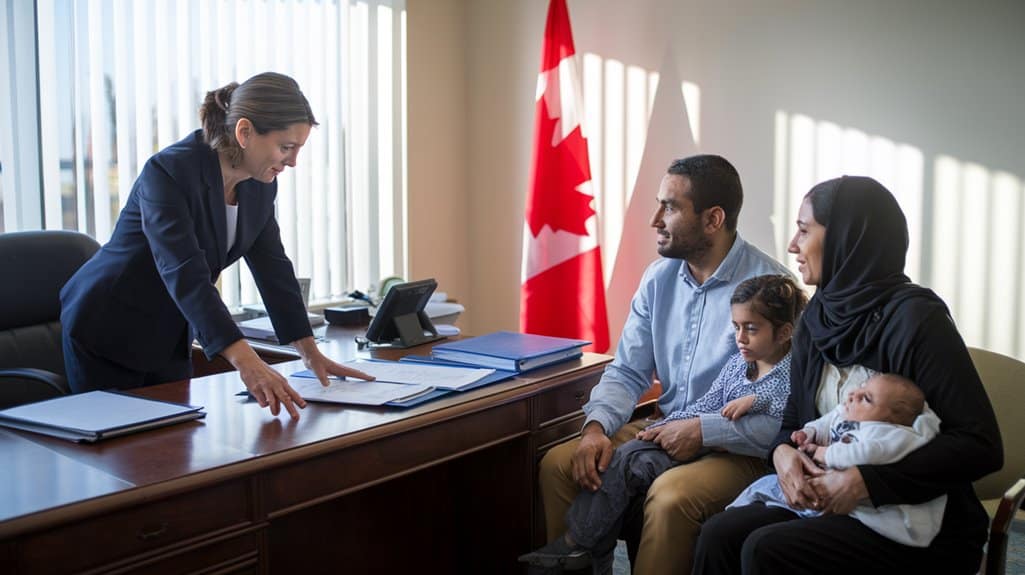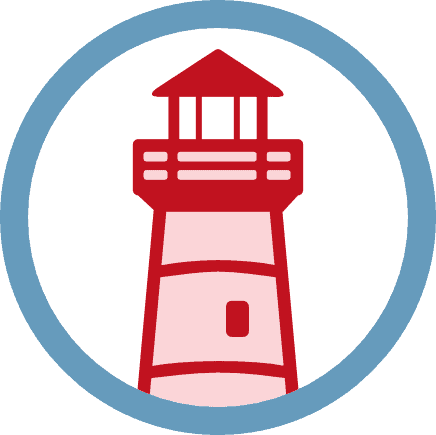
Understanding Canada’s Refugee Protection System
While Canada maintains one of the world’s most extensive refugee protection systems, it’s vital to understand how this system operates before beginning your application process.
You’ll find three main pathways to seek refugee status: making a claim at a port of entry, applying from within Canada, or coming through private sponsorship.
Each pathway has specific eligibility requirements and processes. You’ll need to prove you’re either a Convention refugee with a well-founded fear of persecution or someone who needs protection from risks like torture or cruel treatment.
To qualify for refugee status in Canada, you must demonstrate legitimate persecution risks or the need for protection from inhumane treatment.
The Immigration and Refugee Board (IRB) will assess your claim through a hearing process that typically takes place within 21 months. During this time, you’re eligible to apply for work permits and access essential services while awaiting your decision.
Eligibility Requirements and Important Deadlines
To qualify for refugee protection in Canada, you’ll need to meet specific eligibility criteria and follow strict deadlines.
You’re ineligible if you’ve made a previous refugee claim in Canada, are recognized as a refugee in another country where you can return, or have arrived through a “safe third country” like the United States.
If you’re making your claim at a port of entry, you must submit your Basis of Claim form within 15 days.
For claims made inside Canada, you’ll need to complete all required documentation during your eligibility interview.
You must submit any supporting evidence at least 10 days before your hearing, which typically occurs within 21 months.
If your claim is rejected, you’ll have 15 days to file an appeal, if you’re eligible.
Essential Documents and Application Forms
Several essential documents and forms are required for a complete refugee application in Canada.
You’ll need to submit your Basis of Claim form, which details your reasons for seeking protection, along with valid identification documents like passports or national ID cards. If these aren’t available, you must provide a reasonable explanation why.
You’ll also need to prepare supporting evidence that proves your claim, such as police reports, medical records, photographs, or witness statements.
The Personal Information Form (PIF) must be completed accurately, including your biographical data and travel history.
Don’t forget to include any documents that show your current status in Canada, such as work permits or study visas, if applicable.
Translations of non-English or non-French documents must be certified.
Government Vs Private Sponsorship Pathways
Beyond legal representation, you’ll need to understand the two main pathways for refugee resettlement in Canada.
The Government-Assisted Refugee (GAR) program offers full financial and settlement support from the federal government for one year, while the Private Sponsorship of Refugees (PSR) program relies on Canadian citizens or permanent residents to provide this support.
Under the GAR program, you’ll receive assistance through government-funded organizations, including housing, basic needs, and integration services.
With private sponsorship, your sponsors commit to providing financial and emotional support throughout your first year in Canada. They’ll help you find housing, learn English or French, and connect with community services.
Private sponsors can be groups of five or more individuals, community organizations, or Sponsorship Agreement Holders (SAHs).
Medical Examination and Security Screening Process
When you start the refugee application process in Canada, you’ll need to undergo both medical examinations and security screenings as mandatory requirements.
The medical exam must be performed by a government-approved physician who’ll assess your overall health, check for communicable diseases, and review your medical history.
For security screening, you’ll be required to provide biometric information, including fingerprints and photos.
Officials will conduct thorough background checks to verify your identity and guarantee you don’t pose security risks. They’ll examine police certificates from countries where you’ve lived and investigate any potential connections to criminal activities, terrorism, or human rights violations.
These screenings help protect public health and safety while safeguarding the integrity of Canada’s refugee system.
You can’t complete your application without clearing both requirements.
Rights and Benefits During Application Processing
While your medical and security screenings are being processed, you’ll have access to several important rights and benefits as a refugee claimant in Canada.
You can apply for a work permit, which allows you to support yourself during the application process. You’re also eligible for basic health coverage through the Interim Federal Health Program, covering essential medical services and medications.
You’ll have access to emergency housing assistance if needed, and your children can attend public school.
Social assistance may be available if you meet provincial requirements. You can also access language training programs, settlement services, and legal aid.
Additionally, you have the right to an interpreter during official proceedings and interviews related to your claim.
Next Steps After Decision Notification
Once you’ve received your refugee claim decision from the Immigration and Refugee Board (IRB), you’ll need to take specific actions based on whether your claim was accepted or rejected.
For accepted claims, you can apply for permanent residence status in Canada, while rejected claims require immediate attention to preserve your legal options.
- If accepted, begin your permanent residence application within 180 days, including medical examinations and background checks.
- If rejected, file an appeal with the Refugee Appeal Division within 15 days if you’re eligible.
- Contact legal counsel immediately after a rejection to understand your appeal rights and options.
- Consider requesting a Pre-Removal Risk Assessment if you’re not eligible for an appeal or if your appeal was unsuccessful.
The timing of your next steps is vital, as missing deadlines can affect your status in Canada.
How Canadian Currents Immigration Can Help
Canadian Currents Immigration’s team of experienced lawyers, consultants, and paralegals can provide extensive support throughout your refugee claim process.
We’ll help you comprehend your eligibility, gather necessary documentation, and prepare your application for submission. Our experts will work with you to build a strong case and guide you through complex legal requirements.
You’ll benefit from our decades of combined experience in immigration law as we assist with completing your Personal Information Form, preparing for your Immigration and Refugee Board hearing, and handling any necessary appeals.
We recognize that each refugee claim is unique, so we’ll tailor our services to meet your specific needs. If you need help with work permits, study permits, or permanent residency applications, our team will support you every step of the way.
Frequently Asked Questions
Can Refugee Claimants Choose Which Canadian City to Settle In?
You can initially settle in any Canadian city, but if you’re government-assisted, you’ll be directed to specific locations with support services and refugee reception centers.
What Happens if I Lose My Refugee Documentation During the Application Process?
You’ll need to contact immigration officials immediately to report lost documents. Request replacements of your Personal Information Form and other paperwork. Keep copies of everything in a safe place moving forward.
Are Refugee Children Automatically Enrolled in Canadian Public Schools?
You can enroll your refugee children in public schools while awaiting status. You’ll need to provide your refugee claim documents and proof of residence to the local school board.
Can Refugees Start Their Own Business While Waiting for Claim Decisions?
You can start a business while awaiting your refugee claim decision if you’ve obtained a work permit. You’ll need to follow standard business registration rules and legal requirements.
How Do Seasonal Weather Conditions Affect Border Crossing Refugee Claims?
You’ll face more challenging conditions crossing borders in winter, with increased risks of hypothermia and frostbite. Summer crossings are generally safer but require preparation for heat and dehydration.
Conclusion
If you’re seeking refugee status in Canada, you’ve got multiple pathways available, from port of entry claims to private sponsorship programs. Don’t hesitate to seek legal assistance, as professional guidance can greatly strengthen your application. While the process requires patience and thorough documentation, understanding your rights and following proper procedures will help you present the strongest possible case for protection in Canada.

We serve ALL of Canada. Currently have offices Western Canada — Vancouver, Calgary, Edmonton, Kamloops and Red Deer. We also have the infrastructure to work with any of our clients virtually — even from the furthest regions of the Yukon to Newfoundland.
Call (778) 331-1164 [toll free 1 (844) 715-0940] to get routed to the best office for you or contact us online to schedule an appointment.
We also have a dedicated intake form to help you get the ball rolling. Our intake team will review your specific case and advise you on the next steps to take as well as what to expect moving forward.
Our offices are generally open 8:30 a.m.—4:30 p.m., Mon—Fri.

Alfonso Chen
IMMIGRATION LAWYER
Alfonso is a lawyer of our Vancouver office who provides services in both English and Mandarin. Prior to joining our firm, he worked at a full-service law firm for over four years, where he helped clients with a wide variety of family law matters, from drafting prenuptial agreements to negotiating terms for and drafting separation agreements to representing clients for divorces.



